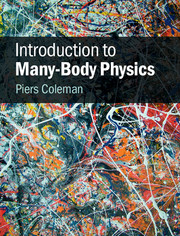Book contents
- Frontmatter
- Dedication
- Contents
- Preface
- Introduction
- 1 Scales and complexity
- 2 Quantum fields
- 3 Conserved particles
- 4 Simple examples of second quantization
- 5 Green's functions
- 6 Landau Fermi-liquid theory
- 7 Zero-temperature Feynman diagrams
- 8 Finite-temperature many-body physics
- 9 Fluctuation–dissipation theorem and linear response theory
- 10 Electron transport theory
- 11 Phase transitions and broken symmetry
- 12 Path integrals
- 13 Path integrals and itinerant magnetism
- 14 Superconductivity and BCS theory
- 15 Retardation and anisotropic pairing
- 16 Local moments and the Kondo effect
- 17 Heavy electrons
- 18 Mixed valence, fluctuations, and topology
- Epilogue: the challenge of the future
- Author Index
- Subject Index
- References
15 - Retardation and anisotropic pairing
Published online by Cambridge University Press: 05 December 2015
- Frontmatter
- Dedication
- Contents
- Preface
- Introduction
- 1 Scales and complexity
- 2 Quantum fields
- 3 Conserved particles
- 4 Simple examples of second quantization
- 5 Green's functions
- 6 Landau Fermi-liquid theory
- 7 Zero-temperature Feynman diagrams
- 8 Finite-temperature many-body physics
- 9 Fluctuation–dissipation theorem and linear response theory
- 10 Electron transport theory
- 11 Phase transitions and broken symmetry
- 12 Path integrals
- 13 Path integrals and itinerant magnetism
- 14 Superconductivity and BCS theory
- 15 Retardation and anisotropic pairing
- 16 Local moments and the Kondo effect
- 17 Heavy electrons
- 18 Mixed valence, fluctuations, and topology
- Epilogue: the challenge of the future
- Author Index
- Subject Index
- References
Summary
This chapter continues our discussion of superconductivity, considering the effects of repulsive interactions and the physics of anisotropic Cooper pairing. According to an apocryphal story, Landau is reputed to have said that “nobody has yet repealed Coulomb's law” [1]. In the BCS theory of superconductors, there is no explicit appearance of the the repulsive Coulomb interaction between paired electrons. How then do real-world superconductors produce electron pairs, despite the presence of the strong interaction between them?
This chapter we will examine two routes by which Nature is able to satisfy the Coulomb interaction. In conventional superconductors, the attraction between electrons develops because the positive screening charge created by the ionic lattice around an electron remains in place long after the electron has moved away. This process that gives rise to a short-time repulsion between electrons is followed by a retarded attraction which drives s-wave pairing. However, since the 1980s physicists have been increasingly fascinated by anisotropic superconductors. In these systems, it is the repulsive interaction between the fermions that drives the pairing. The mechanism by which this takes place is through the development of nodes in the pair wavefunction – often by forming a higher angular momentum Cooper pair. The two classic examples of this physics are the p-wave pairs of superfluid 3He and the d-wave pairs of cuprate high-temperature superconductors.
In truth, the physics community is still trying to understand the full interplay of superconductivity and the Coulomb force. The discovery of room-temperature superconductivity will surely involve finding a quantum material where strong correlations within the electron fluid lead to a large reduction in the sum total of kinetic and Coulomb energy.
BCS theory with momentum-dependent coupling
We now illustrate these two different ways in which superconductors “overcome” the Coulomb interaction, by returning to the more generalized version of BCS theory with a momentum-dependent interaction:
Notice how we have deliberately included a + sign in front of the interaction HI, to emphasize its predominantly repulsive character.
- Type
- Chapter
- Information
- Introduction to Many-Body Physics , pp. 542 - 581Publisher: Cambridge University PressPrint publication year: 2015

